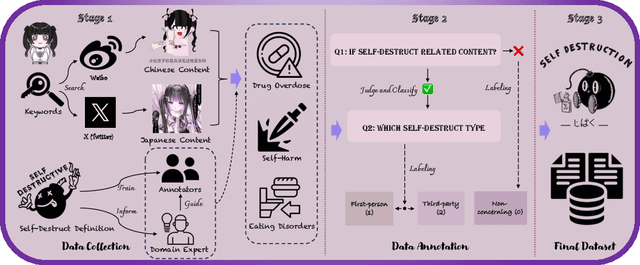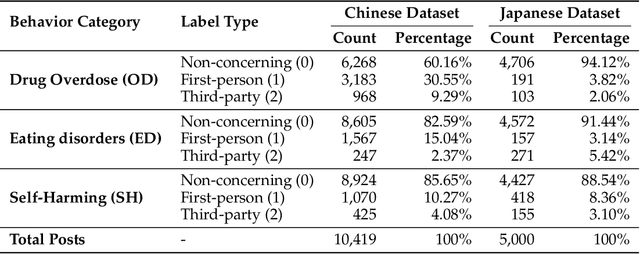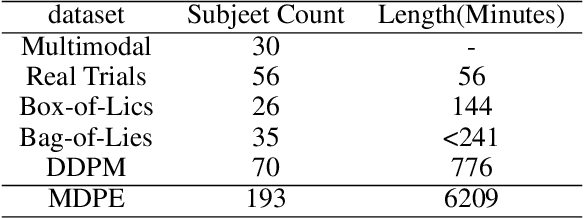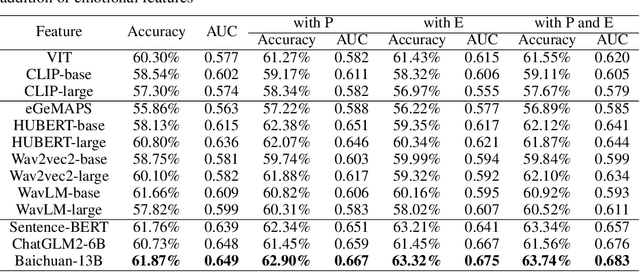Yiming Ma
JiraiBench: A Bilingual Benchmark for Evaluating Large Language Models' Detection of Human Self-Destructive Behavior Content in Jirai Community
Mar 27, 2025



Abstract:This paper introduces JiraiBench, the first bilingual benchmark for evaluating large language models' effectiveness in detecting self-destructive content across Chinese and Japanese social media communities. Focusing on the transnational "Jirai" (landmine) online subculture that encompasses multiple forms of self-destructive behaviors including drug overdose, eating disorders, and self-harm, we present a comprehensive evaluation framework incorporating both linguistic and cultural dimensions. Our dataset comprises 10,419 Chinese posts and 5,000 Japanese posts with multidimensional annotation along three behavioral categories, achieving substantial inter-annotator agreement. Experimental evaluations across four state-of-the-art models reveal significant performance variations based on instructional language, with Japanese prompts unexpectedly outperforming Chinese prompts when processing Chinese content. This emergent cross-cultural transfer suggests that cultural proximity can sometimes outweigh linguistic similarity in detection tasks. Cross-lingual transfer experiments with fine-tuned models further demonstrate the potential for knowledge transfer between these language systems without explicit target language training. These findings highlight the need for culturally-informed approaches to multilingual content moderation and provide empirical evidence for the importance of cultural context in developing more effective detection systems for vulnerable online communities.
Interact with me: Joint Egocentric Forecasting of Intent to Interact, Attitude and Social Actions
Dec 21, 2024



Abstract:For efficient human-agent interaction, an agent should proactively recognize their target user and prepare for upcoming interactions. We formulate this challenging problem as the novel task of jointly forecasting a person's intent to interact with the agent, their attitude towards the agent and the action they will perform, from the agent's (egocentric) perspective. So we propose \emph{SocialEgoNet} - a graph-based spatiotemporal framework that exploits task dependencies through a hierarchical multitask learning approach. SocialEgoNet uses whole-body skeletons (keypoints from face, hands and body) extracted from only 1 second of video input for high inference speed. For evaluation, we augment an existing egocentric human-agent interaction dataset with new class labels and bounding box annotations. Extensive experiments on this augmented dataset, named JPL-Social, demonstrate \emph{real-time} inference and superior performance (average accuracy across all tasks: 83.15\%) of our model outperforming several competitive baselines. The additional annotations and code will be available upon acceptance.
ProteinWeaver: A Divide-and-Assembly Approach for Protein Backbone Design
Nov 08, 2024Abstract:Nature creates diverse proteins through a `divide and assembly' strategy. Inspired by this idea, we introduce ProteinWeaver, a two-stage framework for protein backbone design. Our method first generates individual protein domains and then employs an SE(3) diffusion model to flexibly assemble these domains. A key challenge lies in the assembling step, given the complex and rugged nature of the inter-domain interaction landscape. To address this challenge, we employ preference alignment to discern complex relationships between structure and interaction landscapes through comparative analysis of generated samples. Comprehensive experiments demonstrate that ProteinWeaver: (1) generates high-quality, novel protein backbones through versatile domain assembly; (2) outperforms RFdiffusion, the current state-of-the-art in backbone design, by 13\% and 39\% for long-chain proteins; (3) shows the potential for cooperative function design through illustrative case studies. To sum up, by introducing a `divide-and-assembly' paradigm, ProteinWeaver advances protein engineering and opens new avenues for functional protein design.
ProteinBench: A Holistic Evaluation of Protein Foundation Models
Sep 10, 2024Abstract:Recent years have witnessed a surge in the development of protein foundation models, significantly improving performance in protein prediction and generative tasks ranging from 3D structure prediction and protein design to conformational dynamics. However, the capabilities and limitations associated with these models remain poorly understood due to the absence of a unified evaluation framework. To fill this gap, we introduce ProteinBench, a holistic evaluation framework designed to enhance the transparency of protein foundation models. Our approach consists of three key components: (i) A taxonomic classification of tasks that broadly encompass the main challenges in the protein domain, based on the relationships between different protein modalities; (ii) A multi-metric evaluation approach that assesses performance across four key dimensions: quality, novelty, diversity, and robustness; and (iii) In-depth analyses from various user objectives, providing a holistic view of model performance. Our comprehensive evaluation of protein foundation models reveals several key findings that shed light on their current capabilities and limitations. To promote transparency and facilitate further research, we release the evaluation dataset, code, and a public leaderboard publicly for further analysis and a general modular toolkit. We intend for ProteinBench to be a living benchmark for establishing a standardized, in-depth evaluation framework for protein foundation models, driving their development and application while fostering collaboration within the field.
PuYun: Medium-Range Global Weather Forecasting Using Large Kernel Attention Convolutional Networks
Sep 01, 2024



Abstract:Accurate weather forecasting is essential for understanding and mitigating weather-related impacts. In this paper, we present PuYun, an autoregressive cascade model that leverages large kernel attention convolutional networks. The model's design inherently supports extended weather prediction horizons while broadening the effective receptive field. The integration of large kernel attention mechanisms within the convolutional layers enhances the model's capacity to capture fine-grained spatial details, thereby improving its predictive accuracy for meteorological phenomena. We introduce PuYun, comprising PuYun-Short for 0-5 day forecasts and PuYun-Medium for 5-10 day predictions. This approach enhances the accuracy of 10-day weather forecasting. Through evaluation, we demonstrate that PuYun-Short alone surpasses the performance of both GraphCast and FuXi-Short in generating accurate 10-day forecasts. Specifically, on the 10th day, PuYun-Short reduces the RMSE for Z500 to 720 $m^2/s^2$, compared to 732 $m^2/s^2$ for GraphCast and 740 $m^2/s^2$ for FuXi-Short. Additionally, the RMSE for T2M is reduced to 2.60 K, compared to 2.63 K for GraphCast and 2.65 K for FuXi-Short. Furthermore, when employing a cascaded approach by integrating PuYun-Short and PuYun-Medium, our method achieves superior results compared to the combined performance of FuXi-Short and FuXi-Medium. On the 10th day, the RMSE for Z500 is further reduced to 638 $m^2/s^2$, compared to 641 $m^2/s^2$ for FuXi. These findings underscore the effectiveness of our model ensemble in advancing medium-range weather prediction. Our training code and model will be open-sourced.
MegaFake: A Theory-Driven Dataset of Fake News Generated by Large Language Models
Aug 19, 2024



Abstract:The advent of large language models (LLMs) has revolutionized online content creation, making it much easier to generate high-quality fake news. This misuse threatens the integrity of our digital environment and ethical standards. Therefore, understanding the motivations and mechanisms behind LLM-generated fake news is crucial. In this study, we analyze the creation of fake news from a social psychology perspective and develop a comprehensive LLM-based theoretical framework, LLM-Fake Theory. We introduce a novel pipeline that automates the generation of fake news using LLMs, thereby eliminating the need for manual annotation. Utilizing this pipeline, we create a theoretically informed Machine-generated Fake news dataset, MegaFake, derived from the GossipCop dataset. We conduct comprehensive analyses to evaluate our MegaFake dataset. We believe that our dataset and insights will provide valuable contributions to future research focused on the detection and governance of fake news in the era of LLMs.
EllipBench: A Large-scale Benchmark for Machine-learning based Ellipsometry Modeling
Jul 25, 2024Abstract:Ellipsometry is used to indirectly measure the optical properties and thickness of thin films. However, solving the inverse problem of ellipsometry is time-consuming since it involves human expertise to apply the data fitting techniques. Many studies use traditional machine learning-based methods to model the complex mathematical fitting process. In our work, we approach this problem from a deep learning perspective. First, we introduce a large-scale benchmark dataset to facilitate deep learning methods. The proposed dataset encompasses 98 types of thin film materials and 4 types of substrate materials, including metals, alloys, compounds, and polymers, among others. Additionally, we propose a deep learning framework that leverages residual connections and self-attention mechanisms to learn the massive data points. We also introduce a reconstruction loss to address the common challenge of multiple solutions in thin film thickness prediction. Compared to traditional machine learning methods, our framework achieves state-of-the-art (SOTA) performance on our proposed dataset. The dataset and code will be available upon acceptance.
MDPE: A Multimodal Deception Dataset with Personality and Emotional Characteristics
Jul 17, 2024



Abstract:Deception detection has garnered increasing attention in recent years due to the significant growth of digital media and heightened ethical and security concerns. It has been extensively studied using multimodal methods, including video, audio, and text. In addition, individual differences in deception production and detection are believed to play a crucial role.Although some studies have utilized individual information such as personality traits to enhance the performance of deception detection, current systems remain limited, partly due to a lack of sufficient datasets for evaluating performance. To address this issue, we introduce a multimodal deception dataset MDPE. Besides deception features, this dataset also includes individual differences information in personality and emotional expression characteristics. It can explore the impact of individual differences on deception behavior. It comprises over 104 hours of deception and emotional videos from 193 subjects. Furthermore, we conducted numerous experiments to provide valuable insights for future deception detection research. MDPE not only supports deception detection, but also provides conditions for tasks such as personality recognition and emotion recognition, and can even study the relationships between them. We believe that MDPE will become a valuable resource for promoting research in the field of affective computing.
CLIP-EBC: CLIP Can Count Accurately through Enhanced Blockwise Classification
Mar 14, 2024Abstract:The CLIP (Contrastive Language-Image Pretraining) model has exhibited outstanding performance in recognition problems, such as zero-shot image classification and object detection. However, its ability to count remains understudied due to the inherent challenges of transforming counting--a regression task--into a recognition task. In this paper, we investigate CLIP's potential in counting, focusing specifically on estimating crowd sizes. Existing classification-based crowd-counting methods have encountered issues, including inappropriate discretization strategies, which impede the application of CLIP and result in suboptimal performance. To address these challenges, we propose the Enhanced Blockwise Classification (EBC) framework. In contrast to previous methods, EBC relies on integer-valued bins that facilitate the learning of robust decision boundaries. Within our model-agnostic EBC framework, we introduce CLIP-EBC, the first fully CLIP-based crowd-counting model capable of generating density maps. Comprehensive evaluations across diverse crowd-counting datasets demonstrate the state-of-the-art performance of our methods. Particularly, EBC can improve existing models by up to 76.9%. Moreover, our CLIP-EBC model surpasses current crowd-counting methods, achieving mean absolute errors of 55.0 and 6.3 on ShanghaiTech part A and part B datasets, respectively. The code will be made publicly available.
Robust Multiview Multimodal Driver Monitoring System Using Masked Multi-Head Self-Attention
Apr 13, 2023Abstract:Driver Monitoring Systems (DMSs) are crucial for safe hand-over actions in Level-2+ self-driving vehicles. State-of-the-art DMSs leverage multiple sensors mounted at different locations to monitor the driver and the vehicle's interior scene and employ decision-level fusion to integrate these heterogenous data. However, this fusion method may not fully utilize the complementarity of different data sources and may overlook their relative importance. To address these limitations, we propose a novel multiview multimodal driver monitoring system based on feature-level fusion through multi-head self-attention (MHSA). We demonstrate its effectiveness by comparing it against four alternative fusion strategies (Sum, Conv, SE, and AFF). We also present a novel GPU-friendly supervised contrastive learning framework SuMoCo to learn better representations. Furthermore, We fine-grained the test split of the DAD dataset to enable the multi-class recognition of drivers' activities. Experiments on this enhanced database demonstrate that 1) the proposed MHSA-based fusion method (AUC-ROC: 97.0\%) outperforms all baselines and previous approaches, and 2) training MHSA with patch masking can improve its robustness against modality/view collapses. The code and annotations are publicly available.
 Add to Chrome
Add to Chrome Add to Firefox
Add to Firefox Add to Edge
Add to Edge